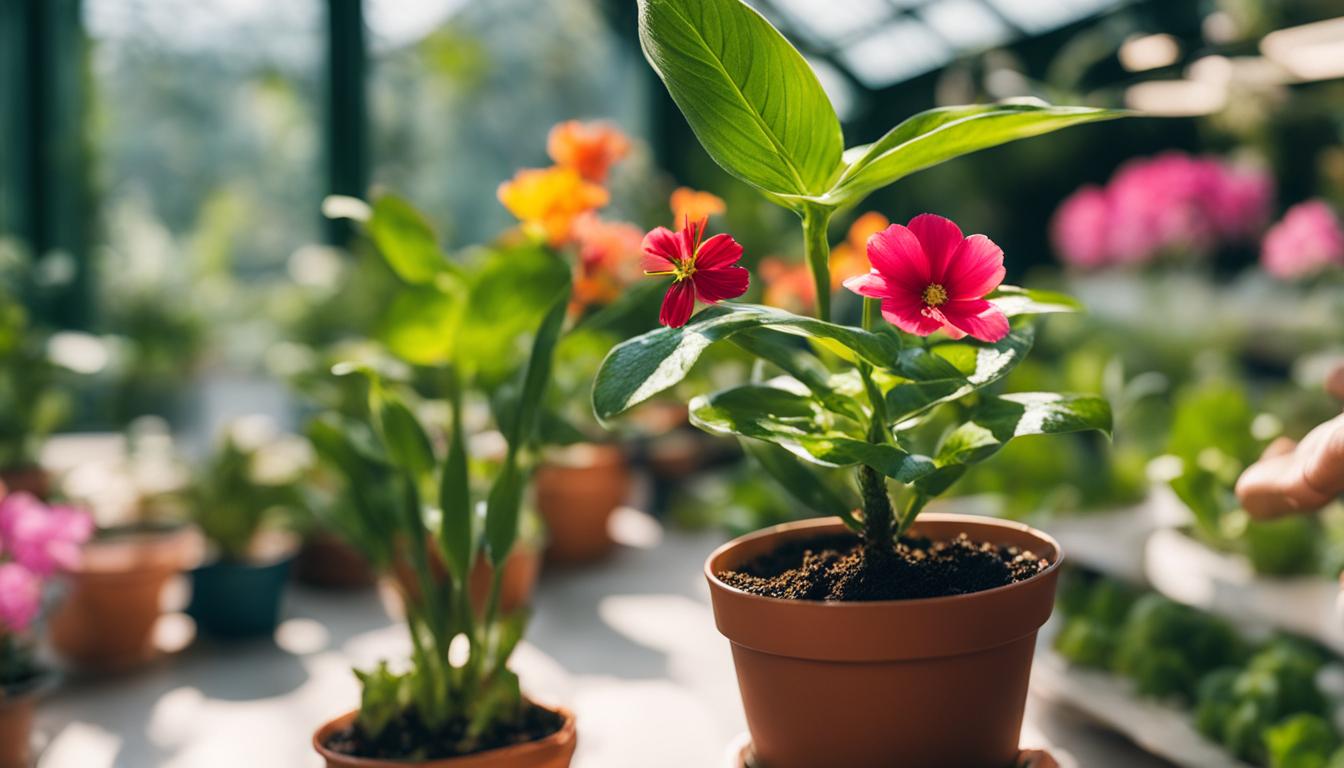
One of the nicest gifts one can give or receive is a flowering potted plant. Blooming plants can be used for interior decorations anywhere.
Follow these guidelines to enhance the blooming period for most plants: keep the soil moist but not soggy, provide full sun or bright light, maintain cool temperatures, and avoid exposing the plants to drafts.
Key Takeaways:
- Proper care can enhance the blooming period of indoor plants.
- Keep the soil moist but not soggy to promote healthy growth.
- Provide full sun or bright light for the plants.
- Maintain cool temperatures and avoid exposing the plants to drafts.
- Regular maintenance is essential to keep indoor blooming plants looking their best.
Selecting Healthy Blooming Plants
When it comes to selecting blooming plants for your indoor space, it’s essential to choose healthy specimens that will thrive and provide long-lasting beauty. Here are some signs to look for when choosing flowering plants for indoors:
- Well-shaped and healthy appearance: Opt for plants with sturdy stems, vibrant foliage, and an overall robust appearance. Avoid plants that have wilted or yellowing leaves, as these may indicate underlying health issues.
- Abundant buds: Check for a large number of unopened buds on the plant. This is a good indicator that the plant is healthy and will continue to produce blooms for an extended period.
- No signs of pests or diseases: Inspect the plant carefully for any visible signs of pests, such as aphids or spider mites, as well as any signs of diseases like powdery mildew or leaf spot. Choosing plants that are free from these issues will help ensure their overall health and longevity.
It’s also a good idea to purchase blooming plants from reputable floral outlets that provide care tips. Look for any attached tags or ask the staff for specific care suggestions. These additional guidelines will further contribute to the successful growth and blooming of your indoor plants.
| Signs of a Healthy Blooming Plant | Signs of an Unhealthy Blooming Plant |
|---|---|
| Sturdy stems and vibrant foliage | Wilted or yellowing leaves |
| Abundant unopened buds | Pest infestation |
| No signs of pests or diseases | Visible signs of diseases |
By following these guidelines and paying attention to the health and quality of blooming plants, you can select specimens that will thrive in your indoor space and bring joy with their beautiful blooms.
Watering Techniques for Indoor Blooming Plants
Proper watering is crucial for maintaining the health and blooming of indoor plants. Understanding the watering needs of your blooming plants will help you provide the right amount of moisture to promote optimal growth and flowering. Here are some effective watering techniques for indoor blooming plants:
How often to water blooming plants?
The frequency of watering depends on various factors such as the type of plant, the size of the pot, the environmental conditions, and the season. In general, it is recommended to check the soil moisture daily and water only when needed.
Feel the soil just below the surface to determine if it’s dry. Overwatering can lead to root rot, while underwatering can cause stress and hinder blooming.
Best watering methods for flowering plants
There are two primary watering methods for indoor blooming plants: top watering and bottom watering. Top watering involves pouring water directly onto the soil surface until it starts to drain from the bottom of the pot. This method allows water to reach the roots more quickly.
Bottom watering, on the other hand, involves placing the pot in a tray filled with water and allowing the plant to soak up the moisture through the drainage holes. This method ensures thorough hydration and promotes healthy root development.
It’s important to note that different plants and container types may require different watering frequencies. Factors such as the plant’s natural habitat, growth stage, and pot material can influence their water requirements.
It’s essential to research and understand the specific watering needs of your blooming plants to ensure their overall well-being and prolonged blooming.
| Plant | Watering Frequency | Watering Method |
|---|---|---|
| Rose | Once a week | Top watering |
| Orchid | Every 7-10 days | Bottom watering |
| Geranium | When the top inch of soil is dry | Top watering |
| Jasmine | Once every 2-3 days | Bottom watering |
Remember to adjust your watering routine based on the specific needs of each plant. Observing the plant’s response, checking the soil moisture, and maintaining a balanced watering schedule will help ensure healthy growth, vibrant blooms, and prolonged flowering.
Providing Adequate Lighting for Blooming Plants
Proper lighting is essential for the healthy growth and blooming of indoor plants. Different flowering plants have varying light requirements, so it is important to provide the best light conditions to promote their blooming.
Most flowering plants thrive in bright, indirect light and should be placed near a window that receives plenty of sunlight.
If you have south-facing or southwest-facing windows, these are ideal for maximizing sunlight exposure.
In cases where natural light is insufficient, artificial lights can be used to supplement the lighting needs of indoor plants. Fluorescent tubes are particularly effective in providing light during the low sunlight winter months.
When positioning your plants, it is advisable to keep them in the same window location to avoid disrupting their light exposure. Sudden changes in lighting conditions can shock the plants and affect their blooming.
It is important to note that some plants may require specific durations of darkness to trigger blooming, so researching the light requirements of your specific plants is crucial.
Light Requirements for Common Flowering Plants:
| Plant | Light Requirements |
|---|---|
| Rose | Full sun (6-8 hours per day) |
| Orchid | Indirect bright light |
| Geranium | Full sun to partial shade (4-6 hours per day) |
| Jasmine | Bright indirect light |
Remember to monitor the light intensity, as too much direct sunlight can damage the foliage and flowers. Additionally, rotating the plants occasionally ensures even light distribution, preventing lopsided growth.
Providing your indoor blooming plants with adequate lighting is crucial for their overall health and blooming success. By understanding their light requirements and ensuring the right conditions, you can enjoy vibrant and beautiful flowers indoors throughout the year.
Optimal Temperature for Indoor Blooming Plants
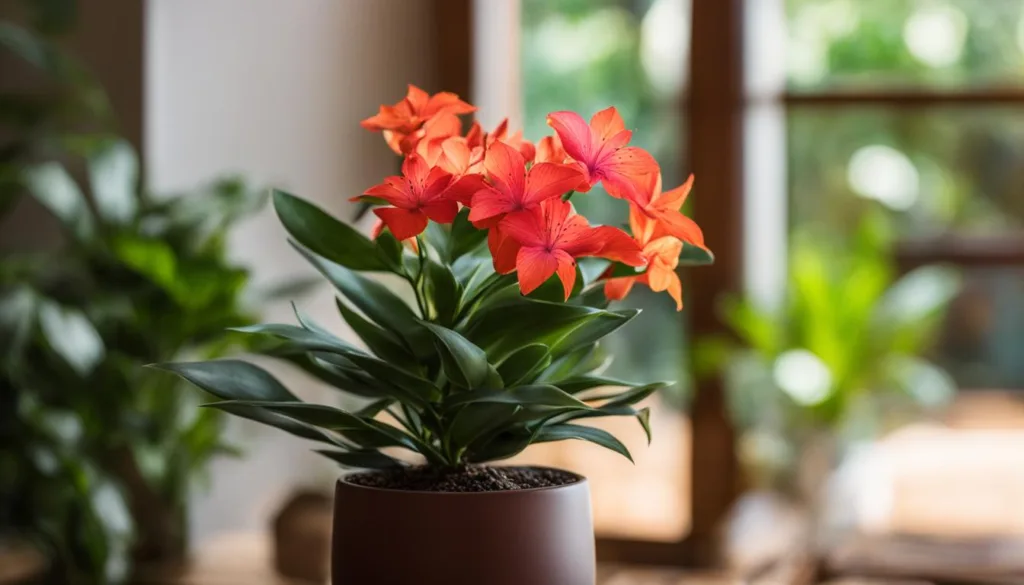
When it comes to maintaining the health and longevity of your indoor blooming plants, providing the optimal temperature is crucial. Different flowering plants have different temperature requirements for optimal blooming.
By understanding and implementing the right temperature conditions, you can ensure that your plants thrive and continue to produce beautiful blooms.
Most blooming plants prefer cooler temperatures than our typical indoor environments. For optimal blooming, aim to maintain temperatures around 65°F during the day and slightly cooler temperatures of 50 to 55°F at night.
This cooler temperature range helps stimulate and prolong the blooming period of your indoor plants.
Avoid exposing your blooming plants to rapid temperature fluctuations and keep them away from hot, dry environments. These extreme conditions can stress the plants and negatively impact their ability to produce and maintain their blooms.
To increase humidity around your plants and provide the ideal growing conditions, consider using humidifiers or other cultural methods.
By maintaining the optimal temperature range for your indoor blooming plants, you can ensure that they stay healthy, vibrant, and continue to produce stunning blooms for you to enjoy.
| Plant | Day Temperature (°F) | Night Temperature (°F) |
|---|---|---|
| African Violets | 65-70 | 60-65 |
| Amaryllis | 65-70 | 50-55 |
| Azaleas | 60-65 | 50-55 |
| Chrysanthemums | 55-60 | 45-50 |
Avoiding Drafts for Indoor Blooming Plants
Protecting your indoor blooming plants from drafts is crucial to ensure their health and longevity. Drafts from air conditioners, windows, doors, fans, fireplaces, or radiators can cause rapid water loss in foliage and flowers, leading to wilting and premature drop.
To prevent unnecessary water loss and keep your blooming plants thriving, it is essential to minimize air movement around them.
To protect your indoor blooming plants from drafts, consider the following tips:
- Place your plants in a location away from air vents or direct airflow.
- Keep doors and windows closed in rooms where the plants are situated.
- Avoid positioning plants near sources of hot air or cold drafts.
- Use room dividers or indoor plant stands to create barriers against drafts.
- During colder months, ensure that your plants are not placed near windows or doors that have a temperature differential.
By implementing these measures, you can create a stable environment for your indoor blooming plants, preventing water loss and maintaining their vibrant blooms for longer periods.
| Common Draft Sources | Tips to Protect Your Plants |
|---|---|
| Air conditioners | Avoid placing plants directly in the path of air vents. |
| Windows and doors | Keep doors and windows closed in rooms with blooming plants. |
| Fans | Position plants away from fan airflow or use fan guards to redirect air. |
| Fireplaces | Avoid placing plants near fireplaces or vents to prevent exposure to hot air. |
| Radiators | Keep plants away from radiators to prevent excessive heat exposure. |
General Maintenance for Indoor Blooming Plants
Proper maintenance is crucial for ensuring the long-lasting beauty and health of indoor blooming plants. By following a few simple guidelines, you can keep your flowering plants looking their best and promote continued blooming. Here are some essential tips for general maintenance:
Removing Faded Blooms
To maintain the appearance of your indoor blooming plants, it’s important to remove faded blooms promptly. Not only does this improve the plant’s aesthetic appeal, but it also helps channel resources towards new growth and future blooms.
Carefully prune off the spent flowers using clean, sharp scissors or pruning shears. Be sure to cut just above a healthy bud or leaf node to encourage branching and new flower production.
Pruning Damaged Leaves and Stems
Regularly inspect your flowering plants for any damaged or yellowing leaves and stems. These can detract from the plant’s overall appearance and may indicate underlying issues such as disease or pest infestation.
Remove any damaged foliage using clean, sterilized pruning tools. Make clean cuts close to the base of the plant to promote faster healing and prevent further damage.
Rotating Plants for Balanced Growth
For even light exposure and balanced growth, it’s beneficial to rotate your indoor blooming plants periodically. This helps prevent the plant from leaning towards a light source, resulting in lopsided growth.
Every few weeks, gently turn the pots a quarter turn in one direction to ensure all sides of the plant receive adequate light. This simple practice promotes symmetrical growth and enhances the overall appearance of your plants.
By following these general maintenance tips, you can keep your indoor blooming plants healthy and beautiful, ensuring they continue to bring joy with their vibrant flowers.
Regularly removing faded blooms, pruning damaged foliage, and rotating the plants will help maintain their appearance and promote continued blooming. With a little care and attention, your indoor flowering plants will thrive and add a touch of natural beauty to your home.
Re-Blooming Techniques for Gift Plants
Gift plants can bring beauty and joy to any home, but their blooms don’t have to be short-lived. With the right care and attention, you can encourage gift plants to bloom again, extending their beauty and adding a touch of nature to your indoor space.
While the quality of re-blooming may not match that of greenhouse-produced plants, following these techniques can help make your gift plants bloom again and prolong their blooming period.
Factors Affecting Re-Blooming
Several factors can influence the re-blooming of gift plants. These include day length, light intensity, watering, feeding, temperature regulation, and pest control.
Each plant may have specific requirements, so it’s important to research and understand the needs of your specific gift plant. Some plants, like African violets, are known for their ease of care and ability to rebloom with the right conditions, while others may require more meticulous manipulation.
General Tips for Re-Blooming
In addition to specific care instructions for each plant, there are some general tips you can follow to encourage re-blooming. These include:
- Providing adequate light: Most gift plants need bright, indirect light to thrive. Place them in a sunny window or supplement with artificial lighting if needed.
- Watering appropriately: Check the moisture level of the soil regularly and water when needed. Avoid overwatering, as it can lead to root rot.
- Fertilizing during active growth: Apply a balanced fertilizer according to the plant’s specific needs. Follow the instructions on the fertilizer package for proper application.
- Maintaining optimal temperatures: Gift plants often prefer cooler temperatures than our homes. Keep them away from drafts and maintain temperatures within their preferred range.
- Managing pests: Regularly inspect your gift plants for any signs of pests and take appropriate measures to control them.
By following these re-blooming techniques and providing the right care, you can help your gift plants bloom again and enjoy their beauty for an extended period.
African Violet Care for Long-Lasting Blooms
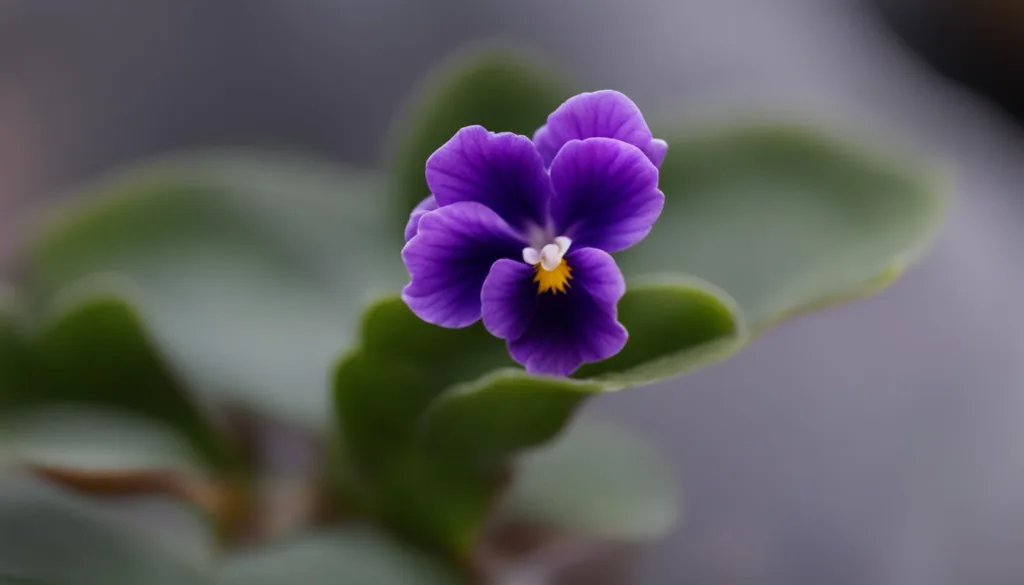
If you’re looking to add a touch of vibrant color to your indoor space, African violets are a perfect choice. These popular houseplants offer a wide range of colors and can bloom year-round if cared for properly.
To ensure long-lasting blooms and healthy plants, here are some essential tips for growing African violets.
Light and Temperature
African violets thrive in bright, indirect light. Place them near a window that receives plenty of natural light, but avoid direct sunlight as it can scorch the delicate leaves. Maintaining a temperature between 65 and 70°F during the day and slightly cooler at night is ideal for these plants. Avoid exposing them to drafts or dramatic temperature fluctuations.
Watering and Humidity
When it comes to watering African violets, it’s important to strike the right balance. Allow the soil to dry slightly between waterings, but avoid letting it become completely dry. Water the plant from the bottom by placing the pot in a tray of water and allowing the roots to soak up the moisture.
This helps prevent water from touching the leaves, which can cause spotting or damage. African violets also appreciate a slightly higher humidity level, so misting the leaves occasionally or placing a small tray of water nearby can help create a more favorable environment.
Fertilizing and Repotting
African violets benefit from regular feeding during their active growth periods. Use a balanced, water-soluble fertilizer specifically formulated for African violets, following the instructions on the package. Be careful not to over-fertilize, as this can lead to burned roots and damaged foliage.
As for repotting, African violets prefer slightly crowded conditions, so only repot them when they outgrow their current container. Use a well-draining potting mix designed for African violets and choose a pot that allows for proper drainage.
With these care tips in mind, you can enjoy the beauty of African violets and their long-lasting blooms. Remember to provide them with the right amount of light, water them properly, and periodically fertilize and repot them when needed.
By following these guidelines, you’ll have healthy, thriving African violets that bring color and joy to your indoor space.
Amaryllis Plant Care for Continuous Blooming
Amaryllis plants are known for their stunning, vibrant blooms that can add a touch of elegance to any indoor space. With proper care, these plants can continue to bloom year after year, providing you with a constant display of beauty. Here are some essential tips for caring for amaryllis plants to ensure continuous blooming:
1. Planting and Placement
Start by planting your amaryllis bulb in a well-drained potting mix, ensuring that the top third of the bulb remains above the soil surface.
Place the pot in a sunny window where the plant can receive at least six hours of bright, indirect light each day. Amaryllis plants thrive in warm temperatures, so aim to keep them in a room with temperatures between 70-75°F (21-24°C).
2. Watering and Feeding
Water your amaryllis plant thoroughly when the top inch of soil feels dry to the touch. Avoid over-watering, as excessive moisture can cause the bulbs to rot. During the growing season, which typically occurs in spring and summer, fertilize your plant every two weeks with a balanced, water-soluble fertilizer. This will provide the necessary nutrients to support continuous blooming.
3. Dormancy and Re-blooming
Amaryllis plants need a period of dormancy to rest and recharge. After the blooming period ends, usually in late winter or early spring, reduce watering and stop fertilizing. Place the plant in a cool, dark location with temperatures around 55-60°F (13-16°C) for 8-12 weeks.
During this dormancy period, the plant will shed its leaves and prepare for the next blooming cycle. After the rest period, return the plant to a sunny window, resume regular watering and feeding, and watch as it begins to sprout and bloom once again.
By following these tips and providing the proper care, you can enjoy the beauty of your amaryllis plant’s continuous blooming for years to come.
Azalea Care for Extended Flowers
Azaleas are beautiful flowering plants that can brighten up any indoor space. To ensure that your azaleas bloom for an extended period, there are a few key care tips to keep in mind.
Proper Lighting
Azaleas require bright but indirect light to thrive. Place your plants in a location that receives ample natural light, such as a sunny window. Avoid direct sunlight as it can scorch the leaves and flowers.
Consistent Moisture
Azaleas prefer moist soil, so it’s important to keep their roots consistently hydrated. Water the plants thoroughly whenever the top inch of soil feels dry to the touch. It’s best to use room temperature water and avoid getting the foliage wet to prevent leaf spotting.
Cool Temperatures
Azaleas thrive in cooler temperatures, ideally around 60-65°F (15-18°C). Avoid placing them near drafty areas or heat sources, as these can cause stress and hinder blooming. Maintaining a cool and stable environment will help prolong the flowering period.
Post-Blooming Care
After your azaleas have finished blooming, continue to care for them to encourage re-blooming in the future. Prune off any faded blooms and shape the plant as desired. Fertilize the azaleas with a balanced fertilizer formulated for acid-loving plants to provide them with the necessary nutrients for healthy growth.
By following these care tips, you can enjoy the vibrant blooms of your azaleas for an extended period. With the right conditions and proper maintenance, your indoor azaleas will continue to bring beauty to your home.
Tips for Caring for Other Indoor Blooming Plants
When it comes to caring for other indoor blooming plants, there are some general care tips that can help you maintain the health and beauty of your flowering houseplants. Each blooming plant has its own unique care requirements, so it’s essential to research specific instructions for different types of plants, such as chrysanthemums, calceolaria, and others.
One crucial aspect of caring for indoor blooming plants is providing them with adequate lighting. Most flowering plants require bright light to thrive, so place them in the brightest window in your house, preferably facing south or southwest for maximum sunlight exposure.
Supplement low winter sunlight with artificial lights, especially with fluorescent tubes. Keeping the plants in the window and avoiding frequent relocation can also contribute to their well-being.
Proper watering is another key element in maintaining different types of blooming plants. Check the soil moisture daily and water only when needed.
Feel the soil just below the surface to determine if it’s dry. Be cautious about overwatering, as it can lead to root rot. Water plants thoroughly until it drains from the bottom of the pot, ensuring proper drainage.
Different plants and container types may require different watering frequencies, so it’s important to understand the specific needs of your blooming plants.
In addition to lighting and watering, maintaining the right temperature and avoiding drafts are crucial for the well-being of indoor blooming plants.
Most flowering plants prefer cooler temperatures than our homes, so aim to keep the temperatures around 65°F during the day and 50 to 55°F at night for optimal blooming.
Protect your plants from drafts caused by air conditioners, windows, doors, fans, fireplaces, or radiators, as they can cause rapid water loss and lead to wilting.
FAQ
How often should I water my indoor blooming plants?
Check the soil moisture daily and water only when needed. Feel the soil just below the surface to determine if it’s dry. Water thoroughly until it drains from the bottom of the pot, but avoid overwatering.
Where should I place my indoor blooming plants for optimal sunlight exposure?
Place them in the brightest window in your house, preferably facing south or southwest for maximum sunlight exposure. Artificial lights can supplement low winter sunlight.
What temperature should I maintain for my indoor blooming plants?
Maintain temperatures around 65°F during the day and 50 to 55°F at night for optimal blooming. Avoid exposing plants to rapid temperature fluctuations and hot, dry environments.
How can I protect my blooming plants from drafts?
Drafts from air conditioners, windows, doors, fans, fireplaces, or radiators can cause rapid water loss and wilting. Minimize air movement around the plants to prevent unnecessary water loss, and keep them away from drafty areas.
How should I maintain my indoor blooming plants?
Remove faded blooms, yellow leaves, and damaged stems promptly. Rotate the plants occasionally for even light exposure. Repot mature plants when necessary and fertilize during active growth periods, following label directions.
Can gift plants be encouraged to bloom again?
Yes, but the quality may not match greenhouse-produced plants. Factors like light, watering, temperature regulation, and pest control can influence re-blooming. Some gift plants, like African violets, can be easily grown and rebloomed with proper care.
How do I care for African violets for long-lasting blooms?
African violets require bright, indirect light, well-drained, moist soil, and temperatures between 65 and 70°F. Avoid direct sunlight and cold water on the foliage. Fertilize monthly with a complete houseplant fertilizer.
How do I care for amaryllis plants for continuous blooming?
Plant bulbs in a well-drained mix, place in a sunny window, and keep soil moist during bloom. Water regularly after flowering to encourage leaf growth. Provide a cool, dry rest period in fall before initiating growth and blooming again.
How can I prolong the blooming period of azaleas?
Keep azaleas in a cool part of the house, provide ample bright but indirect light, and avoid letting the plant dry out. Submerge the pot in water for watering and remove excess water after draining. Continue regular care after flowering to promote re-blooming.
Are there any general care tips for other indoor blooming plants?
Yes, general care tips include providing adequate lighting, watering appropriately, maintaining proper temperatures, avoiding drafts, removing faded blooms, and conducting regular maintenance. Research specific care instructions for different types of blooming plants.

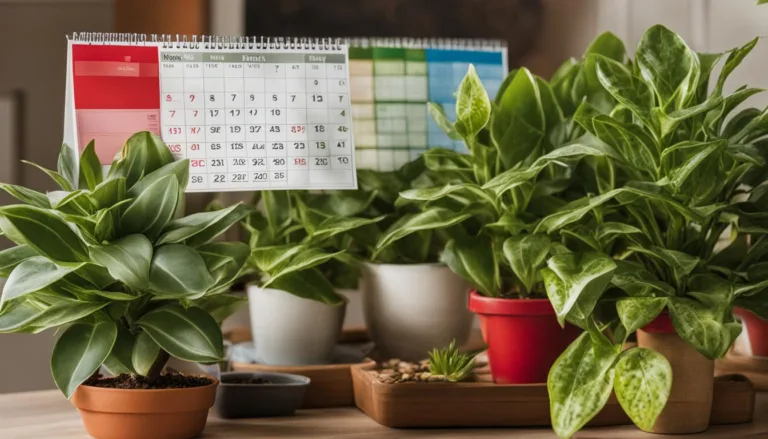
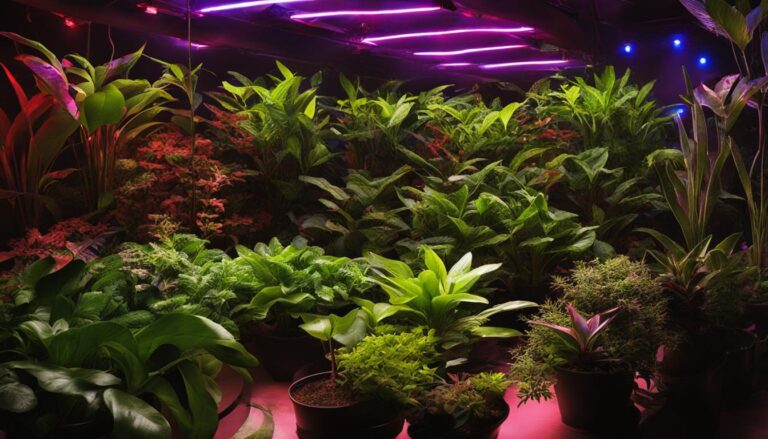
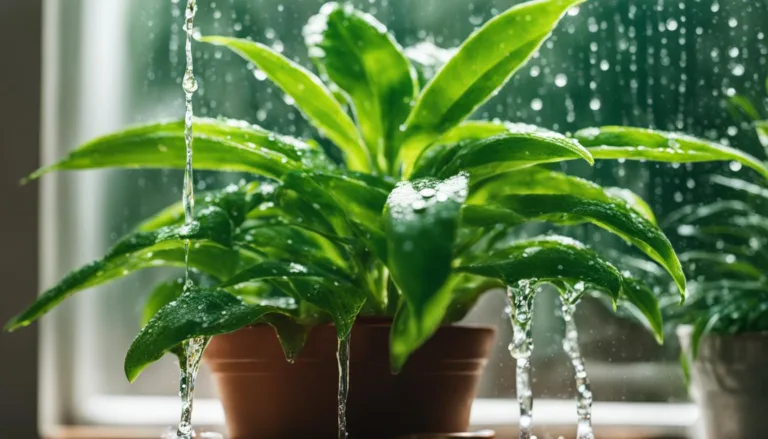
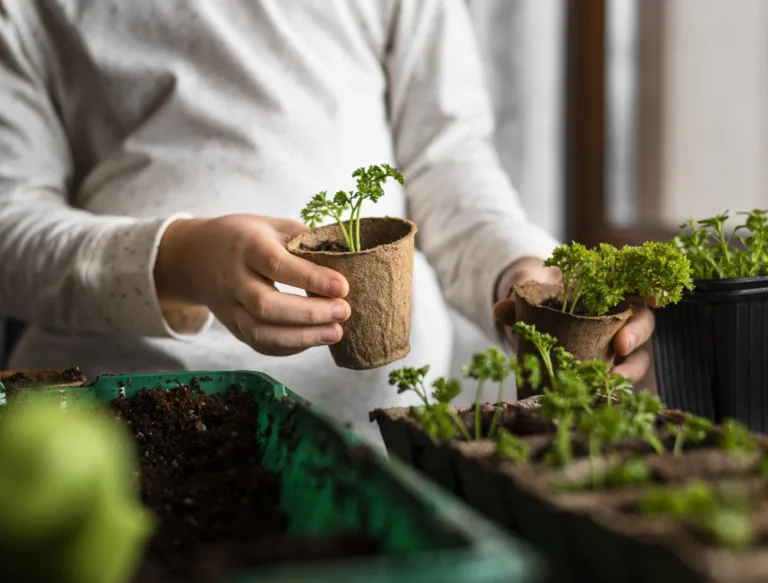
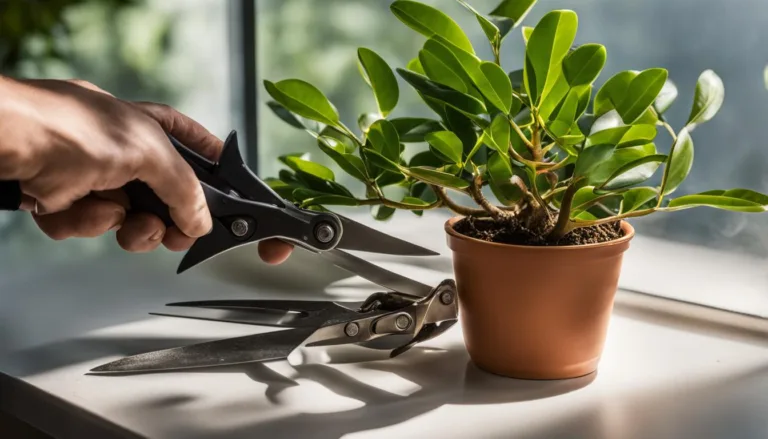
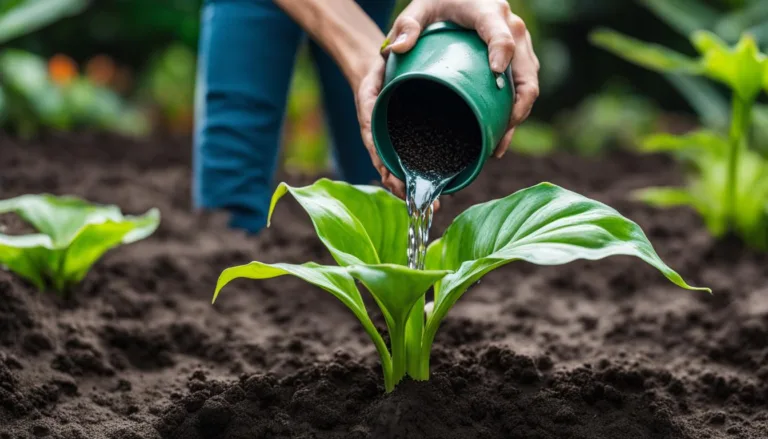
2 Comments
Comments are closed.